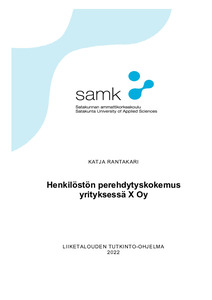Henkilöstön perehdytyskokemus yrityksessä X Oy
Rantakari, Katja (2022)
Rantakari, Katja
2022
All rights reserved. This publication is copyrighted. You may download, display and print it for Your own personal use. Commercial use is prohibited.
Julkaisun pysyvä osoite on
https://urn.fi/URN:NBN:fi:amk-2022060615905
https://urn.fi/URN:NBN:fi:amk-2022060615905
Tiivistelmä
Tämän opinnäytetyön taustalla oli toimeksiantajayrityksen halu ymmärtää henkilöstönsä perehdytyskokemusta ja kiinnostus kehittää ymmärryksen pohjalta nykyistä perehdytysprosessia. Aihe on tärkeä ja ajankohtainen, sillä työntekijänäkökulman huomioiminen liiketoiminnassa on nykyorganisaatioille yhä merkittävämpi kilpailutekijä. Työn ensimmäisenä tavoitteena oli kartoittaa, mitä asioita toimeksiantajayrityksen henkilöstö piti itselleen yleisesti tärkeinä työsuhteen ensimetreillä, millaisia odotuksia uuteen työsuhteeseen kohdeyrityksessä ladattiin ja millainen työntekijäkokemus henkilöstölle muodostui saadusta perehdytyksestä. Työn toisena tavoitteena oli tarjota yritykselle kehitysehdotuksia, jotka tukevat työntekijälähtöisempää perehdytystä.
Opinnäytetyön teoreettinen tietoperusta muodostui perehdytyksen ja työntekijäkokemuksen käsitteistä. Ensimmäisessä teorialuvussa käsiteltiin perehdytyksen eri osa-alueita ja ajallisia vaiheita sekä korostettiin perehdytyksen laajaa roolia tulokkaan kokonaisvaltaisessa sopeuttamisessa organisaatioon. Lisäksi tarkasteltiin perehdytyksen tehtäviä, tavoitteita ja onnistumisen edellytyksiä. Toisessa teorialuvussa käsiteltiin laajasti työntekijäkokemusta, näkökulmia sen kehittämiseen ja työntekijäkokemuksen yhteyttä perehdytykseen.
Työn empiirisen osion tiedonkeruu toteutettiin laadullisella teemahaastattelulla viidelle henkilölle. Tutkimustulokset osoittavat, että henkilöstö kokee nykyisen perehdytyksen varsin onnistuneena. Ristiriitoja odotusten ja todellisuuden välillä ei erityisemmin ilmennyt. Perehdytyskokemusta paransivat esimerkiksi tyytyväisyys perehdyttäjään ja kollegoihin, turvallinen ilmapiiri sekä työnkuva. Kokemusta heikensivät esimerkiksi huoli omasta osaamisesta ja oppimisesta, tiedonkulun ongelmat sekä räätälöinnin puute. Kehitysehdotuksissa painotettiin suunnitelmallisuuden, räätälöinnin sekä seurannan ja palautteen merkitystä. Tiedonkulkua ehdotettiin parannettavan tietopohjaisella organisaatiokaaviolla. Myös lähitukihenkilön nimeäminen ja laajempi verkostoituminen nähtiin mahdollisina kehityskohteina. Lisäksi todettiin, että huomiointi ja pienet eleet tulokkaan ensimmäisenä päivänä voivat vahvistaa positiivista työntekijäkokemusta. This thesis was commissioned by a company that seeks to understand the onboarding experience of its employees and aspires to develop its onboarding process. The topic is relevant to the present given that employee satisfaction is an increasingly important competitive advantage for modern organizations. The first objective of this work was to investigate which things the company’s newcomers find meaningful when joining a new organization, what expectations they set on their employment in the company, and what their overall onboarding experience in the company was like. The second objective of the thesis was to provide the commissioner with suggestions and ideas on how to develop the onboarding process considering the employee perspective.
The theoretical framework consisted of two key concepts: onboarding and employee experience. The phases, areas, functions, and objectives of onboarding were defined. The factors that contribute to incorporating a new hire successfully into an organization were also examined. The concept of the employee experience was thoroughly explored and its close connection to onboarding was recognized.
The empirical part of the work relied on qualitative research methods. The data were collected by conducting five semi-structured interviews with the employees. The results showed that the employees were fairly satisfied with their onboarding experience. No considerable conflicts between their expectations and their actual experience were detected. The factors that enhanced the employees’ onboarding experience during their first months were, among others: satisfaction with the onboarding supervisor, a good rapport with colleagues, and a psychologically safe environment. The experience was deteriorated by, for example: concerns about one’s capabilities, problems with information exchange, and a lack of personalization of the onboarding plan. As for developing the current onboarding process, the company should be more transparent about the onboarding plan and tailor it together with the employee. Consistent evaluation and feedback should be a priority. The new and old employees might benefit from an organizational chart based on information flow. Creating a buddy program to help socialize the new hire, enabling networking outside the immediate team, and welcoming the newcomer with small gestures on day 1 could also potentially improve the overall experience.
Opinnäytetyön teoreettinen tietoperusta muodostui perehdytyksen ja työntekijäkokemuksen käsitteistä. Ensimmäisessä teorialuvussa käsiteltiin perehdytyksen eri osa-alueita ja ajallisia vaiheita sekä korostettiin perehdytyksen laajaa roolia tulokkaan kokonaisvaltaisessa sopeuttamisessa organisaatioon. Lisäksi tarkasteltiin perehdytyksen tehtäviä, tavoitteita ja onnistumisen edellytyksiä. Toisessa teorialuvussa käsiteltiin laajasti työntekijäkokemusta, näkökulmia sen kehittämiseen ja työntekijäkokemuksen yhteyttä perehdytykseen.
Työn empiirisen osion tiedonkeruu toteutettiin laadullisella teemahaastattelulla viidelle henkilölle. Tutkimustulokset osoittavat, että henkilöstö kokee nykyisen perehdytyksen varsin onnistuneena. Ristiriitoja odotusten ja todellisuuden välillä ei erityisemmin ilmennyt. Perehdytyskokemusta paransivat esimerkiksi tyytyväisyys perehdyttäjään ja kollegoihin, turvallinen ilmapiiri sekä työnkuva. Kokemusta heikensivät esimerkiksi huoli omasta osaamisesta ja oppimisesta, tiedonkulun ongelmat sekä räätälöinnin puute. Kehitysehdotuksissa painotettiin suunnitelmallisuuden, räätälöinnin sekä seurannan ja palautteen merkitystä. Tiedonkulkua ehdotettiin parannettavan tietopohjaisella organisaatiokaaviolla. Myös lähitukihenkilön nimeäminen ja laajempi verkostoituminen nähtiin mahdollisina kehityskohteina. Lisäksi todettiin, että huomiointi ja pienet eleet tulokkaan ensimmäisenä päivänä voivat vahvistaa positiivista työntekijäkokemusta.
The theoretical framework consisted of two key concepts: onboarding and employee experience. The phases, areas, functions, and objectives of onboarding were defined. The factors that contribute to incorporating a new hire successfully into an organization were also examined. The concept of the employee experience was thoroughly explored and its close connection to onboarding was recognized.
The empirical part of the work relied on qualitative research methods. The data were collected by conducting five semi-structured interviews with the employees. The results showed that the employees were fairly satisfied with their onboarding experience. No considerable conflicts between their expectations and their actual experience were detected. The factors that enhanced the employees’ onboarding experience during their first months were, among others: satisfaction with the onboarding supervisor, a good rapport with colleagues, and a psychologically safe environment. The experience was deteriorated by, for example: concerns about one’s capabilities, problems with information exchange, and a lack of personalization of the onboarding plan. As for developing the current onboarding process, the company should be more transparent about the onboarding plan and tailor it together with the employee. Consistent evaluation and feedback should be a priority. The new and old employees might benefit from an organizational chart based on information flow. Creating a buddy program to help socialize the new hire, enabling networking outside the immediate team, and welcoming the newcomer with small gestures on day 1 could also potentially improve the overall experience.
